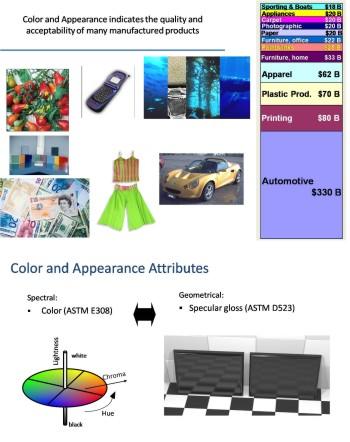Summary
We are developing instrumentation, standards artifacts, and measurement protocols to characterize appearance attributes including color, texture, and gloss under a variety of geometrical conditions with the best possible accuracy, thereby addressing the demand for traceable measurements and standards.
Description

The quality of an object—be it fruit at the grocery store, clothes in the department store, or a new car on the dealer's lot—is often judged by its color and appearance. Appearance greatly influences a customer's judgement of the quality and acceptability of manufactured products, as yearly there is approximately $700 billion worth of shipped goods for which overall appearance is critical to their sale. Although the need for accurate measurements of these attributes has been recognized for many decades, increasing globalization—particularly in manufacturing—and new materials, such as pearlescent coatings, have spurred efforts to have these measurements be traceable to standards maintained by national metrology institutes.
The appearance of an object is the result of a complex interaction of the light field incident upon the object, the scattering and absorption properties of the object, and human perception. The measurable attributes of appearance are divided into color (hue, saturation, and lightness) and geometry (gloss, haze). The appearance of an object cannot be measured; only the specific reflectance characteristics of the surface are measured.
The NIST Physical Measurement Laboratory has established an appearance metrology laboratory. This new laboratory provides calibration services for 0°/45° colored samples, 20°, 60°, and 85° specular gloss samples, research in the colorimetric characterization of gonioapparent including a new standards for metallic coatings and calibrated photographic and X ray step tablets.
Surface color
The surface color of an object depends upon several factors – the spectral power distribution of the illuminant, the spectral sensitivity of the observer, the geometrical conditions of illumination and observation, and the optical properties of the object. Only the last factor depends upon the object, and it is quantified by the spectral reflectance factor for opaque reflecting materials under the given geometrical conditions. Once the spectral reflectance factor is known, the tristimulus values are calculated for a given illuminant and observer, and from these values other quantities are derived, such as chromaticity coordinates and color space values. The NIST 0:45 Reflectometer was designed to provide calibrated reflectance color standards with a target for color difference of ΔE*ab < 0.5 as the primary design specification. The primary purpose of the 0:45 Reflectometer is to disseminate color standards to the color and appearance community through a set of calibrated color tiles, British Ceramic Research (BCRA) series II. These tiles are used to transfer the NIST 0:45 color scale to other instruments. For more information, see 0:45 Surface color calibrations.
Specular gloss
Specular gloss is the perception by an observer of the mirror-like appearance of a surface. A reference goniophotometer, which is in compliance with the industrially important ASTM and ISO standards and a new specular gloss primary standard with several advantages over other standards, has been developed and characterized at NIST to provide a calibration service for specular gloss at the 20°, 60°, and 85° geometries. In addition, this instrument is capable of performing absolute bi-directional luminous reflectance measurements at angles from 0° to 70° for the incident and viewing angles in compliance with ASTM standard recommendations.
Special effects coatings
Materials are being manufactured with new and unique appearance attributes that are not always adequately characterized by traditional measurement techniques. For example, gonioapparent coatings, such as those used in the application of paint for automobiles, exhibit differences in their color and appearance with changing illumination or viewing angle. Consequently, a traditional single-geometry measurement, such as 0:45, is not capable of characterizing the perceived color variability of these coatings. Thus, NIST has designed the five-axis goniometer to measure the bi-directional reflectance over a wide range of illumination and viewing angles for in-plane and out-of-plane geometries. A sample can be rotated in three different axes, allowing illumination from any direction in the hemisphere about the sample with the objective of differentiating between the scattering mechanisms present in the complex surfaces of gonioapparent materials.
Transmission density
Transmission density is an important physical property for exposed films in the fields of medicine, non-destructive testing, photography, and graphic arts. Calibrated Standards for transmission density are provided by NIST in the form of film step tablets, 254 mm long by 35 mm wide, with steps extending the width of each film and equally spaced along its length. The steps have increasing transmission densities from approximately 0.1 at one end of the film to 4 at the other. A double emulsion X-ray film has 17 steps and a single emulsion photographic film has 23. The transmission densities of the film step tablets are determined with an instrument using the diffuse influx mode. Diffuse illumination is achieved with a flash opal, while directional detection is accomplished with a lens system. The transmitted radiant flux is detected by a temperature-controlled silicon (Si) photodiode with amplifier electronics capable of measuring signals spanning seven orders of magnitude. The instrument is designed to automatically measure many films using computerized data acquisition and control.
Major Accomplishments
Provide calibrated standards for surface colored samples, specular gloss plaques, and x-ray and photographic step tablets. Research on new special effect coatings.
Measurements 0:45 surface color
20, 60, and 85 Specular gloss calibrations
BRDF measurements of special effect pigments
Photographic and X-ray step tablets standards and recalibrations

